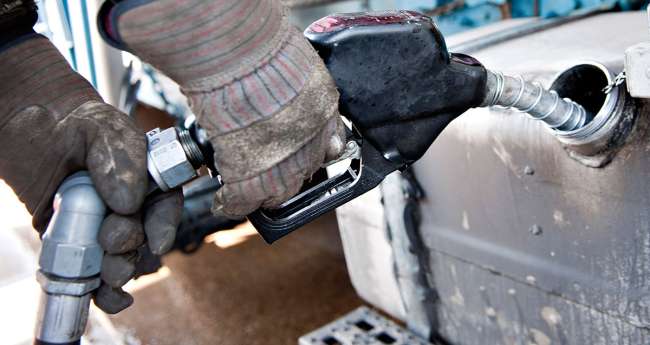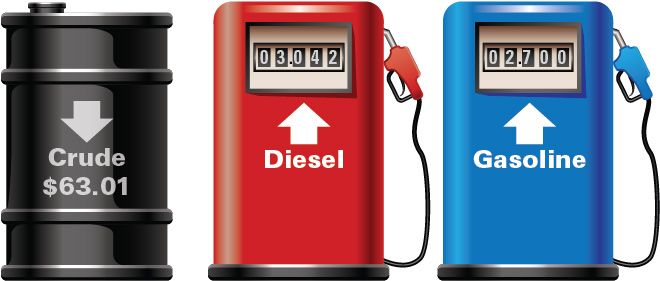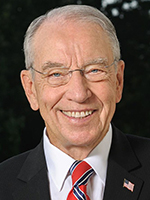Senior Reporter
Diesel Rises 3.2¢ to $3.042 a Gallon

The U.S. average retail price of diesel rose 3.2 cents to $3.042 as oil fell to $63 a barrel on low trading volumes that reflected uncertainty over a U.S. trade war with China.
Trucking’s main fuel costs 48.6 cents a gallon more than it did a year ago, when the price was $2.556, the Department of Energy said April 2. It was the second consecutive increase in diesel’s average price after six consecutive declines. The price has risen 7 cents in that period.
The average price of diesel rose in all regions.
The national average price for regular gasoline rose 5.2 cents to $2.700 a gallon, DOE’s Energy Information Administration said. The average is 34 cents higher than it was a year ago.
One analyst said oil prices are headed up soon, and with that, diesel prices, amid the tightest relationship between supply and demand in several years.
Supplies of oil are below average while demand for oil is at a record high by U.S. refiners. As refiners come out of maintenance, it is going to drive the price of crude oil up, Phil Flynn, senior energy analyst at The Price Futures Group, told Transport Topics.

“I really think that we are headed higher [with oil prices], potentially much higher, over the coming month. We have seen near record demand for gasoline and record exports and a strong global economy,” Flynn said.
The price of oil accounts for 48% of the cost of a gallon of diesel, according to DOE.
“Diesel can run, but it can’t hide,” he said.
“One of the problems we are seeing with diesel production is shale oil, which doesn’t really produce a lot of distillate fuel and that really starts to drive the [diesel] market a little bit higher,” Flynn added.
At the same time, anger is mounting over the Environmental Protection Agency’s awarding of exemptions to refiners who otherwise would have to comply with the Renewable Fuel Standard. However, EPA denied any change in previous administrations’ criteria.
EPA has given more than two dozen small refiners permission to ignore the nation’s renewable fuel mandate, angering competitors as well as farm-state lawmakers who say the exceptions undermine the program, according to Bloomberg News.
Allowing refineries to escape annual blending quotas undermines the mandate requiring refiners and fuel importers to mix ethanol and other biofuels into gasoline and diesel, Sen. Chuck Grassley (R-Iowa) a fierce defender of the U.S. renewable fuel requirement, told Bloomberg.

Grassley
“It appears EPA granted a secret waiver that is legally reserved for small refiners to one of the largest oil refining companies in the country,” Grassley said in an e-mail statement to Bloomberg.
A coalition of American ethanol suppliers said EPA appears to be “pressing its thumb on the scale” to grow oil company profits.
The latest exemptions are intended “to effectively reduce the overall demand for biofuels in this country absent any public discourse,” Growth Energy CEO Emily Skor wrote in a letter to EPA protesting the exemptions.
Meanwhile, oil prices are comparable with December 2014, when the price of crude was sliding down from that year’s peak price of $107.26 reached June 20.
West Texas Intermediate crude futures on Nymex closed at $63.24 per barrel April 4 compared with $65.55 on March 26.
Also, U.S. commercial crude oil inventories fell by 4.6 million barrels from the previous week, EIA reported March 30.
The market had expected a drop of 1.6 million barrels, according to Stephen Sly, president of risk-management firm Stabilitas Energy Inc.
The decline in U.S. stockpiles has boosted optimism that surging shale output may not thwart OPEC’s efforts to drain a glut, according to Bloomberg News. While prices have been buoyed by America’s potential withdrawal from a nuclear deal with OPEC producer Iran, a gathering trade conflict between the United States and China — the world’s two largest economies — has kept a lid on gains.
At the same time, concerns about a downturn in the U.S. economy are surfacing.
“The U.S. economy is showing a lot of symptoms of being late-cycle,” Marc Chandler, global head of currency strategy at Brown Brothers Harriman & Co., told Bloomberg. “I’m looking for a downturn in maybe late next year or early 2020, with the fiscal stimulus they’re getting from the White House giving us a little bit of late-cycle expansion but nothing that changes the game plan.”




